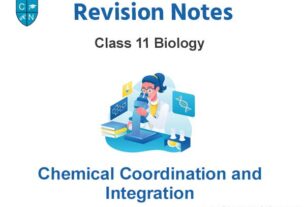Please refer to Cellular Level of Organisation Class 7 Science notes and questions with solutions below. These revision notes and important examination questions have been prepared based on the latest Science books for Class 7. You can go through the questions and solutions below which will help you to get better marks in your examinations.
Class 7 Science Cellular Level of Organisation Notes and Questions
INTRODUCTION OF CELL
• The cell is defined as : “A unit of biological activity, delimited by a differentially permeable membrane & capable of self reproduction in a medium free of other living systems” or “Cell is the structural and functional unit of living organisms”.
• The branch of biology which deals with the study of cell and cell organelles is known as cytology.
(a) Discovery of Cell :
• Robert Hooke was the first coin the term ‘Cell’ for small structures in a piece of cork under a microscope (1665).
• This observation was published in his book named “Micrographia”.
• Anton Van Leeuwenhoek in 1674 observed living cells i.e. one celled structures like bacteria, protozoans and blood cells under microscope for the 1st time.
(b) Cell Theory :
It was proposed for the I” time by the German botanist M.J. schleiden (1838) and German zoologist T. Schwann (1839).
• Outcomes of cell theory includes:
(i) A cell is the basic unit of life.
(ii) Cells are present in all organisms.
• Modern cell theory or cell principle or cell doctrine states
(i) All organisms are made up of cells.
(ii) Cell does not arise de novo (DenovoSpontaneous). Cells arise from pre-existing cells. (Omnis cellular-a-cellula) added by Rudolf Virchow.
(iii) Cells contain hereditary material.
(iv) A cell is a small mass of protoplasm, usually containing a nucleus or nuclear material al ong with some organelles.
(v) Cells are physiological unit of life.
(vi) Each cell is capable of maintaining its vitality independently.
MICROSCOPY
It is the practice of using microscope for the study of finer details of small objects including cells and tissues. Microscopes are Instruments consisting of lenses which magnify and resolve small objects not visible to unaided eye for the study of their details. A microscope has more than one lens. In microscopy, the sample to be viewed is first stained (in most cases) with a dye and then viewed under the microscope. Staining highlights specific regions in the cell which makes it easier for us to view its details. Some commonly used staining dyes are safranin, methylene blue and crystal violet.
• Early Microscopes: First laboratory microscope was developed by Robert Hooke (1665). It was simple and had a combination of magnifying lenses fixed in a tube. Another simple but more powerful microscope was built by Leeuwenhoek (1674). With the help of his microscope, Leeuwenhoek made many discoveries ahead of his time.
• Structure of microscope: The microscope used in schools is called compound microscope. It has an upper tubular part called the body tube. It has magnifying lenses at both of its ends. The upper part has a magnifying lens called eyepiece. The lower part has a place where 2 or 3 magnifying lenses are attached. These are called as the objectjves. The object to be examined is placed on the stage under the objective. Light on the object is focussed through the mirror, and the object is seen through the eyepiece.
Now a days, highly developed kind of microscopes are used in big government and private research centres for research and develop ment (R & 0) purpose. These are the electron microscopes.

CELL SHAPE
Cell shows variability with respect to their shape and size in multicellular organisms. Shape of the cell may be variable i.e. constantly changing e.g. Amoeba and leucocytes;or fixed . The shape of the cell is usually related to its function.
• Fixed shapes of cells are of following types :
(i) Flattened e.g., Skin cells (upper layer).
(ii) Columnar e.g., cells lining the intestine.
(iii) Discoidal e.g., R.B.C.
(iv) Spherical e.g., eggs of many animals.
(v) Spindle sha ped e.g., Smooth muscle fibres.
(vi) Elongated e.g., nerve cells.
(vii) Branched0 e.g., pigment cells of the skin. (viii)Bean shaped e.g., Gaurd cells of stomata e.g. Melanocytes.
CELL SIZE
• Size of cell vary from very small cells of bacteria (0.2 to 0.5 11m) to the very large egg of ostrich.
• Smallest cell -PPLO I Mycoplasma gal/isepticum (Pleuro-pneumonia like organism) 0.1 -0.5 Jlm in size.
• Largest cell -Ostrich egg ~15 em without shell & 18 cm in diameter with shell.
• Longest cell -nerve cell ~ 1 -1.5 m in length.
TYPE OF CELLS
(a) On the basis of type of organization, cells are of two types:
(i) Prokaryotic cells : These are primitive and incomplete cells. They have less developed nucleus without nuclear membrane and nucleolus.e.g. Bacteria.
(ii) Eukaryotic cells: These are well developed cells. They have dvanced nucleus with nuclear membrane and nucleolus. e,g. Plants & animals.
(b) Differences between Prokaryotic & Eukaryotlc Cells :

TYPES OF ORGANISM
(a) On the Basis of Number of Cells Organisms can be Categorized as :
(i) Unicellular organisms : These are the organisms which are made up of single cell only. This single cell performs all the vital body functions of an organism. e.g. Amoeba
(ii) Multicellular organisms: These are the organisms which made up of numerous cells. These cells then combine to form an organ and group of organs performing different functions forms an organ system which further forms an organism.e.g. Plants and animals

CELL STRUCTURE
• Each cell of plants or animals comprises of following parts.
(i) Cell membrane
(ii) Cytoplasm
(iii) Nucleus
CYTOPLASM
• It is the site of both biosynthetic and catabolic pathways.
• It can be divided into two parts:
(i) Cytosol or Hyaloplasm: Aqueous soluble part contai ns various fibrous proteins forming cytoskeleton.
(ii) Cell organelles : Living part of the cells having definite sha pe, structure and function bounded by plasma membrane.
CELL WALL
• It is the outermost covering of the plant cells.
• It is absent in animal cells.
• Cell wall is rigid, strong, thick, porous and non living structure. It is made up of cellulose and hemicellulose. Cell walls of two adjacent cells are joined by a layer called middle lamella~. It Is made up of calcium and magnesium pectate.
Functions of cell wall :
• It provides definite shape to the cell.
• It provides strength to the cell.
• It is permeable for the entry of molecules of different sizes.
CELL MEMBRANE
• Cell membrane is also called as Plasma Membrane or Plasmalemma.
• It is the limiting boundary of each cell which separates the cytoplasm from its surroundings.
• It is found in both plant as well as animal cells.
• It is the outer most covering of a cell in case of animals and lies below the cell waH in case of plants.
• It is made up of proteins (58-59%),lipids (40%) and carbohydrate (1 .5%).
• Plasma membrane name was given by Nageli.
• Plasma membrane is selectively permeable in nature.
It allows or permits the entry and exit of some materials in and out of the cell.
(i) Functions of plasma membrane:
(A) It regulates the movement of molecules inside and outside the cell.
(B) It helps in maintaining the distinct composition of the cell.
• Transportatron of molecules across the plasma membrane: Th is can be done by following ways :
(A) Diffusion : Movement of molecules of gases, liquids and solutes or ions from higher concentration to lower concentration is called as diffusion. It does not require energy therefore it is called as passive transport.
(B) Osmosis: The movement of solvent or water from region of their lower concentration (pure water or dilute solution) to a region of their higher concentration (concentrated solution), when the two are seperated by a semipermeable membrane . Osmosis can also be called as “diffusion of solvents”.
• Endosmosis: Movement of solvent into the cell is called as Endosmosis.
• Exosmosis : Movement of solvent outside the cell is called as Exosmosis.

• Nucleus is the most important cell organelle which directs and controls all its cellular activities.
• It is called as “Headquarter of the cell”.
• It was discovered by “Robert Brown in 1831”.
• In eukaryotes a well defined nucleus is present while in prokaryotes a well defined nucleus is absent.
• Prokaryotes contain a primitive nucleus.
• Structure : It has a double layered covering called as nuclear membrane or karyotheca. Nuclear membrane has pores which regulate the movement of materials in & out of the cell. Besides nuclear membrane nucleus also contains nucleolus (function-r R A and ribosome synthesis) and chromatin material and the substance filled inside the nucleus is nucleoplasm or karyolymph. Chromosomes or chromatin material consists of DNA (Deoxyribonucleic acid), RNA (Ribose nucleic acid) and basic proteins (eg. Histone). Chromatin material stores and transmits hereditary information for the cell to function, grow and reproduce,
Gene : Gene is a unit of inheritance in living organisms. It controls the transfer of a hereditary characteristic from parents to offspring. This means that your parents pass some of their characteristics on to you. If your father has brown eyes, you may also have brown eyes. If your mother has curly hair, you might also end up having curly hair However, the different combination of genes from parents result in different characteristics.
• Functions of the Nucleus:
(A) It controls all the metabolic activities of the cell and regulates the cell cycle.
(B) It helps in transmission of hereditary characters from parents to offsprings.
CELL ORGANELLES
• These are living sub-cellular structures of the cytoplasm and are also called protoplasmic bodies or organolds. These includes
• Double membrane bound organelles-Mitochondria and Plastlds.
• Single membrane bound organelles -Endoplasmic reticulum, Golgi apparatus, lysosome, Vacuole etc.
• Non-membrane bound organelles-Ribosomes etc.
(I) DOUBLE MEMBRANE BOUND ORGANELLES :
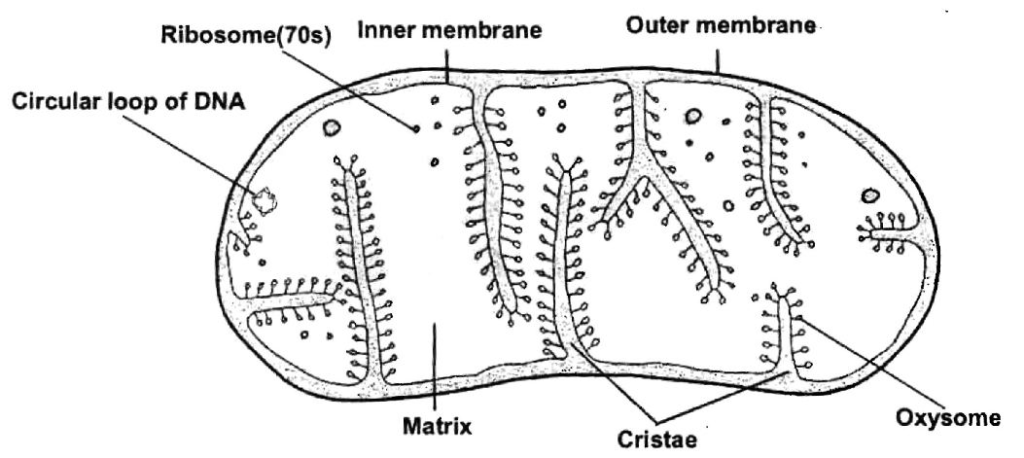
It was first seen by Kolliker in insect cells and named by Benda. l! is found in cytoplasm of all eukaryotic cells except mammalian RBC’s. These are also absent in prokaryotes. Maximum mitochondria are found in metabolically active cells . It is also called as “Power House of the Cell” or the “Storage Battery” . Structure: It is a rod shaped structure. It is double membranous structure where outer membrane is smooth while inner membrane is folded inside to form Cristae.”Cristae” are the infoldings of inner mitochondrial membrane that possess ATP synthesizing units called Oxysomes or F 0 -F1 Particles. The F 1 particles also called as fernandez morans particles. Space between inner and outer mitochondrial membranes is called as perimitochondrial space. The fluid present In mitochondria is called as matrix. Matrix contains enzymes for Kreb cycle.
Matrix contains circular DNA molecule and ribosomes, therefor mitochondria is called semiautonomous organelle.
• Functions:
(i) Its main function is to produce and store the energy in the form of ATP.
(ii) It is the site of Kreb cycle of respiration.
(iii) Oxysome contains enzymes for ATP production.
• Plastlds: Plants and some protists have several types of double membrane bound organelles called plastlds, which harvest solar energy, manufacture nutrient molecules and store materials.
• Plastid term was coined by E.Haeckel.
• Plastids generally contain pigments and may synthesize & accumulate various substances.
Plastids are of three types:
(i) Chloroplasts (Chlore -green plastids) : They take part In photosynthesis to produce life supporting gas oxygen and most of the energy (glucose) used on our planet by living beings. Blue green algae lack chloroplasts and have loosely arranged membrane in the cytoplasm in the form of sacs of typical unit membrane structure called lamellae.
• First seen by AV Leeuwenhoek.
• Structure:
(A) The outer covering of chloroplast has an envelope composed of two unit membranes made up of lipoprotein .
(B) Stroma: It is a granular transparent substance also called as matrix. Grana are embedded in it.
(C) Grana: It constitute the lamellar system. These are found layered on top of each other, these stacks are called as grana. Each lamella is made up of unit membranes.
• Each granum of the chloroplast is formed by 10-100 rounded, flat, sac like structures stacked one above the other like a pile of coins, such rounded flat and closed compartments are called thylakold .
• In each thylakoid of grana lamellae , Quantasomes are present which are called photosynthetic units.
• Each quantasome possess 230 chlorophyll molecules.
• Different grana are connected with the help of tubular connections, called stroma lamellae or frets channel.
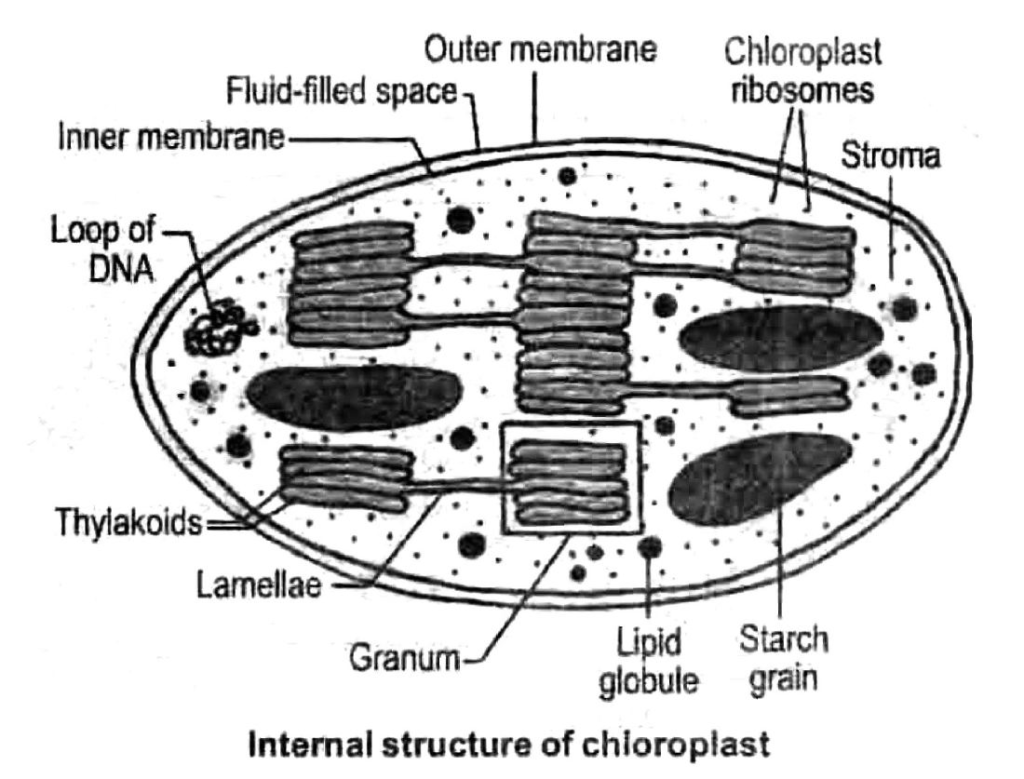
Function :
• Stroma is the site of dark reaction of photosynthesis. Also helps In protein synthesis due to presence of ribosomes.
• Grana are the sites of light reactron of photosynthesis as they contain photosynthetic pigment chlorophyll.
(ii) Chromoplasts: These are coloured plastids (other than green) found in petals. fruits and roots of certain higher plants.
• The red colour of ripe tomatoes IS the result of chromoplasts which contain the red pigmen called Iycopene.
(iii) Leucoplasts :
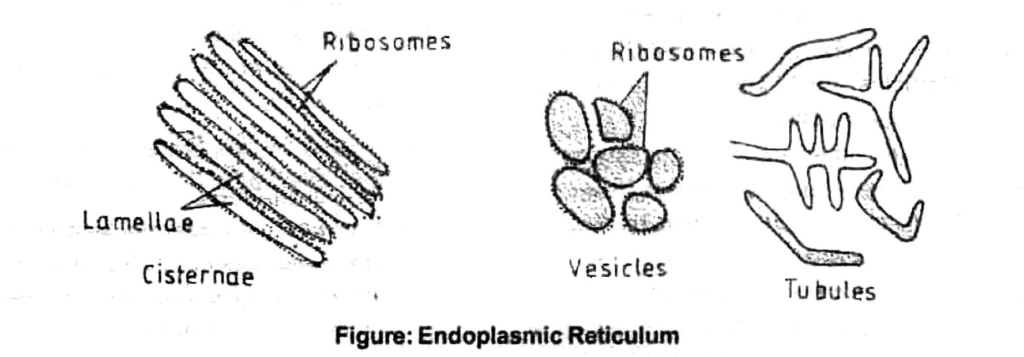
* These are colourless plastids, found in underground plant parts which are not exposed to light. They store food materials.
* These are also found in embryonic cells, germ cells and meristemetic cells.
* These are classified cells.
* These are classified into
(A) Amyloplasts – Store starch
(B) Etaioplasts – Store fats & essential oils
(C) Proteinoplasts orr Aleuroplast – store proteins
(II) SINGLE MEMBRANE BOUND ORGANELLES :
* Endoplasmic reticulum

• Functions of ER:
(i) It acts as cell-circulatory system and he lps in transportation of materials between different parts of cell.
(ii) It forms cytoskeleton of cell.
(iii) It helps in synthesis of proteins, polysaccharides, fats, steroids, cholesterol etc.
(iv) Helps in membrane biogenesis.
• Golgi Apparatus :

* It was discovered by Camilo Golgi.
* It is absent in prokaryotes, mammalian RBC’s & sieve cells.
* In plants golgi body is called as Dictyosome.
Structure :
* It is single membrane bounded.
* Golgi apperatus consists of flat sacs or seccules or parallel membrane called cisternea, which are arranged in sack one above the other. These stacks are surrounded at the circumference (periphery) by vesicies and vacuoles.
Functions :
(i) It is secretory in nature.
(ii) It helps in formation of middle lamellae
(iii) It helps in formation of lipids
(iv) It helps in melanin and hormone synthesis
(v) Lipids and proteins synthesized in endoplasmic reticulum are packed at golgi complex.
(vi) They provide the site for assembly of new membrane material.
• Lvsosomes (Lyso =digestive, soma =body)
• Discovered by Christian de Duve.
• They occur in animal cells and a few plant cells.
• Commonly known as “Suicidal Bags”.
• They do not have a definite shape or size.
• They are bounded by a single membrane.
• These are tiny sac like granules containing hydrolysing enzymes called acid hydrolases for intracellular digestion.

• Functions :
• Their main function is phagy = digestion
• They are kind of waste disposal system .
• They help in digesting foreign materials and worn out cells.
During disturbances in cellular metabolism I.e. in case of cell damage Iysosomes burst and their enzymes are released into the cytoplasm and they digest their own cell so they are also called as “Suicidal Bags”.
• Vacuoles
• Vacuoles are non-living structures of cytoplasm and also called cell inclusions or ergastic bodies.
• Some animal cells may have one to a few small fluid filled vacuoles.
• In general plant cells possess one or a few large vacuoles,
• These are bounded by a single membrane called tonoplast.
• Functions:
(i) These serve for storage and the transport of dissolved. secretory or excretory substances.
(ii) Help In maintenance of an pressure in plant cells.
Intracellular turgor
(iii) Some fresh water unicellular animals posses 1, 2 or few contractile vacuoles bounded by a simple and delicate membrane dirferent from typical unit membrane. They help in excretion & osmoregulatJon (regulation of water level in the cell).
(III) NON MEMBRANE BOUND ORGANELLES:
• Ribosomes
• First reported by Claude and named by G. Palade. They are one of the smallest cell organelles of cell.
• It is of two types that is 70s(Prokaryotic).80s (Eukaryotic).
• Ribosomes are the sites of protein synthesIS. All structural and functional (enzymes) proteins coded by the nuclear DNA, are synthesied upon cytoplasmic ribosomes.

DIFFERENCE BETWEEN PLANT CELL & ANIMAL CELL

SOME IMPORTANT TERMINOLOGIES
* Cell : Cell is the structural and functional unit of living organisms.
* Cell Wall : Structure present outside the cell membrane in plant cells.
* Centriole : Organelle present in animal cells which help in cell division.
* Chromosome : Small, thread – like structure in the nucleus of a cell.
* Mitochondria : Power house of cell
* Ribosome : Protein factory of cell. Engine of cell.
* Lysosome : Suicidal bag of cell.
* Nucleus : Head quarter of cell.
Olympiad Problems NCERT Class 7 Cellular Level of Organisation
Question. An exception of cell theory is
(A) bacteria
(B) protists
(C) algae
(D) virus
Answer
D
Question. Cell theory was expanded by
(A) Schleiden
(B) R.Virchow
(C) Brown
(D) Grew
Answer
A
Question. Which scientist used the term “Omnis cellulae cellula” ?
(A) Robert Hooke
(B) Anton Van Leeuwenhoek
(C) Rudolf Virchow
(D) M.J. Schleilden
Answer
C
Question. Which one of the follOWing IS correct according to cell theory.
(A) Cell is the basic unit of life.
(B) All the organisms are made up of cells.
(C) All cells arise from pre-existing cells.
(D) All are correct.
Answer
D
Question. Cell theory was proposed by .
(A) M.J. Schlelden & T.Schwann
(B) F. Miesher
(C) W. Flemming
(D) F. Strasbrger
Answer
A
Question. Cell membrane is
(A) unhaminar
(B) bilaminar
(C) trilaminar
(D) quardrilaminar
Answer
C
Question. A biomembrane is made up of
(A) Proteins, Lipids & Carbohydrates
(B) Proteins, Lipids & RNA
(C) Proteins, Lipids & DNA
(D) Proteins, Lipids & Hormones
Answer
A
Question. Nucleus is concerned with
(A) respiration
(B) secretion
(C) control of cellular activities
(D) protein synthesis
Answer
C
Question. ………………………….. is made up of cellulose.
(A) cell wall
(B) cell membrane
(C) cytoplasm
(D) nucleus
Answer
A
Question. Functions of endoplasmic reticulum is are
(A) support
(B) circulation
(C) lipid synthesis
(D) all of the above
Answer
D
Question. Rough endoplasmic reticulum is involved in
(A) protein synthesis
(B) lipid synthesis
(C) both (A) & (B)
(D) none of the above
Answer
A
Question. In cell the site of oxidation is
(A) ribosome
(B) golgi apparatus
(C) mitochondrion
(D) endoplasmic reticulum
Answer
C
Question. Green pigments capable of capturing the energy of sunlight are located within the ;
(A) Golgi complex
(B) Endoplasmic reticulum
(C) Chloroplasts
(D) Cell wall
Answer
C
Question. Chloroplast are found in :
(A) All cells
(B) All eukaryolic cells
(C) Only in animal cells
(D) Only in plant cells
Answer
D
Question. Prokaryotic ribosome has two subunit of
(A) 405 + 40s
(B) 50 + 30s Resonance
(C) 60 + 405
(D) 20 +r-30s
Answer
B
Question. Eukaryotic 80S ribosome has two subunits of :
(A) 405 + 405
(B) 60S + 405
(C) 60S + 50S
(D) 50S + 305
Answer
B
Question. Which one of the following structure is also known as ergastic body :
(A) Lysosome
(B) Nucleus
(C) Vacuole
(D) Mitochondria
Answer
C
Question. Which cell organelle is known as protein factory :
(A) Ribosome
(B) Nucleolus
(C) Nucleus
(D) Mitochondria
Answer
A
Question. Single membrane is present in
(A) mitochondrion
(B) chloroplast
(C) nucleus
(D) lysosome
Answer
D
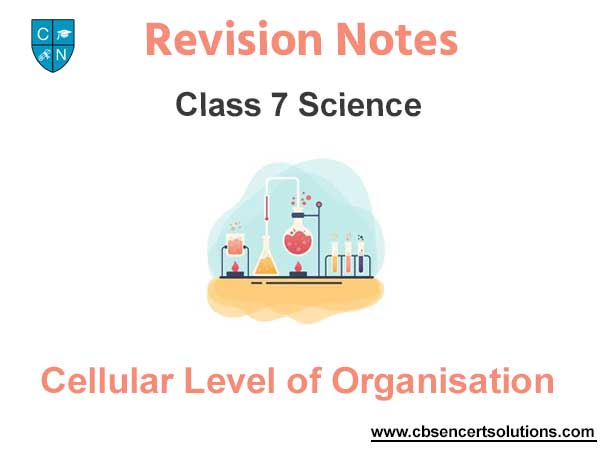
We hope the above Cellular Level of Organisation Class 7 Science are useful for you. If you have any questions then post them in the comments section below. Our teachers will provide you an answer. Also refer to MCQ Questions for Class 7 Science

